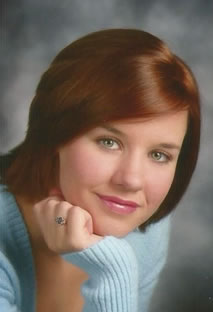
Before starting as an Undergraduate Sociology Teaching and Research Student (USTARS) in the fall of 2014, senior sociology and psychology double major Kayla Smith was no stranger to research.
In 2013, Kayla was hesitant about becoming involved in research. After taking a research methods course in fall that year, however, Kayla gained more confidence in her ability to perform the tasks necessary in sociological and psychological research. That same year, Kayla began working in the Subtle Prejudice Lab at the UNL Psychology Department with Dr. Sarah Gervais. During this time, Kayla worked with entering data, interacting with study participants, and other assigned tasks. After getting a taste of psychological research in the Subtle Prejudice Lab, Kayla decided she wanted to do more research related to sociology.
In spring 2014, Kayla learned about USTARS from Dr. Patricia Wonch Hill. She applied, was accepted, and immediately became involved in the ongoing Science Education Partnership Award project called “Biohuman” (learn more about this project at the following link: http://worldofviruses.unl.edu/). The study involves web-based surveys of an entire middle school twice a year for two years. One goal of the study is to understand how middle-school aged youths develop science identities and their understanding of what “science” means to them.
Kayla explained that science identity has to do with how much students consider themselves a “science kind of person”. The survey also asked youth what they think of as “science”, and after given some options (e.g. studying stars or rocks), also allowed study participants to write in their own ideas (i.e. open-ended responses). Kayla spent time categorizing the answers to the question “what is science”. Reading through and coding all of the statements students had about science allowed Kayla to code responses as narrow or broad. Kayla’s preliminary analyses show interesting findings about the association between the breadth of ideas about science and science identities. Working with Dr. Hill, she found that students who have broader notions of science have higher science identities than students with more narrow notions of science. For example, a student who defines science as a process of asking and trying to answer questions is more likely to consider themselves a science kind of person than a student who defines science as only the study of chemicals, minerals, or animals.
“It’s important for youths to maintain an interest in math and science, as well as to maintain interest in STEM careers,” Kayla said. “As a society, we need more people in STEM careers. So it’s important to understand how identity can help shape an individual’s relationship with math and science.”
Kayla’s USTARS internship is still ongoing. Nevertheless, her research has provided her with many learning experiences and opportunities.
Kayla says her work in USTARS has given her a snapshot of the kinds of projects she will be involved with in graduate school. In addition, Kayla’s research in USTARS led her to write a research paper which she has recently submitted for the ASA (American Sociological Association) conference.
Story by Lane Chasek